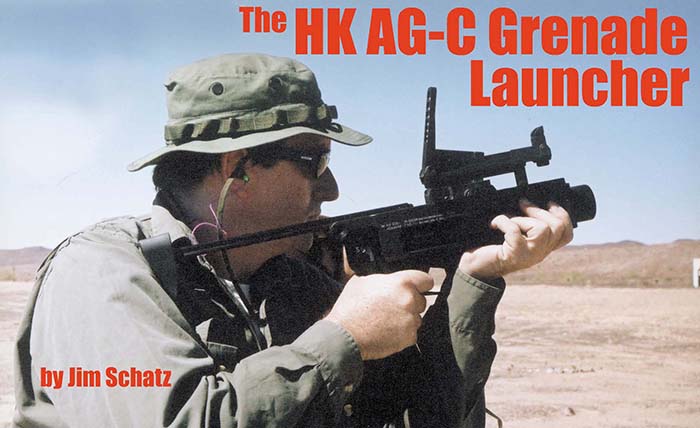The HK AG-C in stand-alone configuration being fired during endurance testing at the Yuma Proving Ground in September 2002.
by Jim Schatz
During the 1960s development efforts in the United States resulted in the perfection of a high/low propulsion system to safely and accurately launch tube-fired 40mm grenades from the operator’s shoulder. This development quickly resulted in the design of various single-shot launchers, both stand-alone models like the well know US M79 and more importantly the add-on 40mm grenade launcher we have known for decades in the US as the M203, first adopted in 1968. Arguably the most commonly encountered add-on rifle-mounted launcher in the world and at last count used by more than 40 countries, the M203 proved successful the concept of a “dual purpose” weapons system, one that allows the operator to accurately engage point targets with rifle ammunition or area, protected or defilade targets using high explosive grenades by means of a relatively lightweight and easily portable package. With more than 20 various types of rounds available presently or previously in the United States and many more of foreign origin, the add-on grenade launcher allows the user to launch all manner of ordnance including lethal HE, fragmentation and anti-personnel rounds as well as less-than-lethal rounds and a wide assortment of pyrotechnic and marking cartridges. A great idea and an even better tactical tool.
The standard M203 attaches to the host rifle by means of a special receiver and hand guard design that is by no means quickly detachable and must be mounted or dismounted at unit armorer level. A grenadier in a conventional unit is assigned those duties on a more or less permanent basis so there have historically been few reasons to make the M203 easily removable from the host weapon. That being said, quick-detachable (QD) versions of the M203 have been fielded for the U.S. M4A1 Carbine with US special operations forces in the SOPMOD (Special Operations Peculiar Modification) Kit and with foreign users who desire greater flexibility in the configuration of their individual weapon. These QD M203’s can be quickly attached to the rifle or carbine with special integral adapters to increase the modularity of the weapon system and thus the tactical flexibility of the user. Why carry a 3-pound grenade launcher if it is not necessary? Conversely if the 40mm capability is required, it should be available to every combatant without a need for the exchange of his or her assigned rifle or the need for extensive modifications to the host weapon to accommodate the launcher. The ability to utilize the launcher in a stand-alone mode like the M79 also has some attractive tactical applications as well.
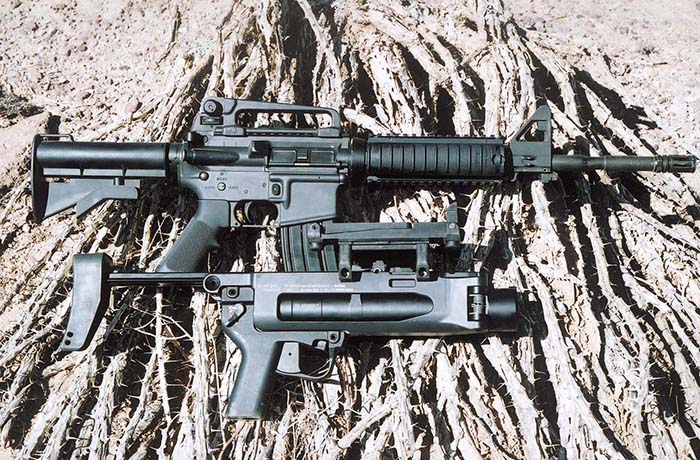
With the almost universal popularity of today’s four-quadrant modular rail systems for accessory attachment it was only a matter of time before the small arms community created an add-on 40x46mm low velocity grenade launcher that could be attached to these rail systems just as the operator might attach a vertical fore grip, flashlight or laser aimer. It would, however, be necessary to insure the rail system could withstand the constant firing of a projectiles weighing upwards of 1/2-pound launched at more that 270 fps. Heckler & Koch now offers a grenade launcher that fits this exact description and with many improvements deemed superior by various user groups both here in the United States and overseas.
Item Description
In 2000 Heckler & Koch began the production of a new family of lightweight breech-loaded single-shot 40x46mm add-on grenade launchers termed AG for “Anbaugerat” (translation “mounted implement”). The first model of the HK AG launcher to be developed was the AG36 for use on the 5.56x45mm HK G36 rifle and carbine. The German and Spanish armies now employ the AG36, providing the dual-weapon capability that was previously lacking in their armed forces. The AG36 attaches to the gas block of the G36 rifle by means of a special hand guard, which in turn is secured to the aluminum receiver of the launcher. A large removable locking pin is inserted through one of two holes through the handguard and the corresponding hole in the gas block mounted on the barrel. This arrangement insures a rigid mounting interface that easily allows 5,000 plus rounds to be fired with no damage or degradation to the weapon systems performance. As the gas blocks of the G36 are mounted at various locations on the barrels of the various variants there is a mounting position for the 18.9- and 15.4-inch rifle-length barrels and the 12.5-inch carbine barrel.
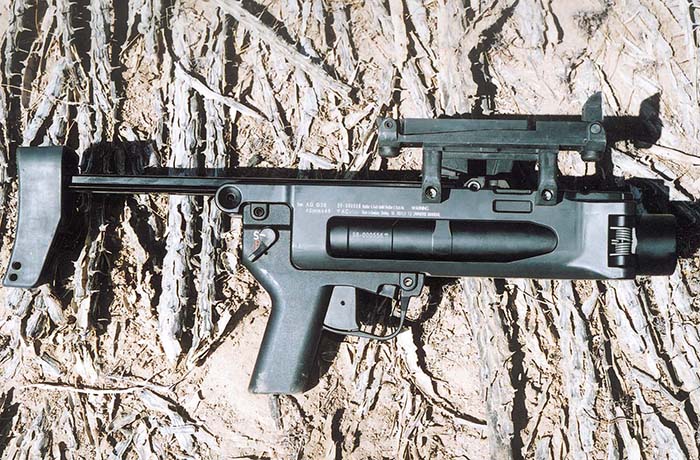
An integral polymer pistol grip is attached to the receiver. It includes a rotary safety switch with safe and fire positions, breech release button within the trigger guard and unique double-action-only trigger mechanism. To fire the AG launcher the operator uses his non-firing, or weak hand, on the launcher’s pistol grip to disengage the safety and depress the double-action-only trigger. This insures that the strong hand remains on the operating controls of the host rifle at all times. The aluminum receiver houses the side-swinging, rifled, aluminum 11-inch barrel that is spring-actuated. In the event the barrel does not spring open slots in the receiver allow the operator to manually persuade the barrel open. The receiver has threaded mounting points for the attachment of a variety of sight options.
HK AG Variants
Other variants of the HK AG grenade launcher have been created for an assortment of host weapons. One thousand AG-C launchers (“C” for Colt Carbine) were developed based on the AG36 for use on the British C8 Carbine, the Diemaco licensed variant of the U.S. M4 Carbine. Fitted with the Knights Armament Rail Attachment System (RAS), the British C8 with AG-C launcher has been in service with the British Special Air Service for more than two years, to include combat service in “the sand pile.” A variant of the AG launcher also can be attached to the US M16A2 rifle or its variants. In fact, the Dutch military employs the AG-NL (“NL” for Netherlands) on their C7 Rifle, a Canadian Diemaco copy of the US M16A2 Rifle, and their C8 Carbine, the Canadian-produced copy of the Colt M4 Carbine. In the NL variant, the launcher attaches not to a MIL-STD-1913 rail, as is the case with the AG-C, but to the standard handguard mounting position normally occupied by the standard lower handguard section. A variant of the HK launcher called the AG SA80 has also been developed for the British SA80 Individual Weapon (L85), 600 of which are already in service with British forces. With the exception of the mounting interface above the receiver, the basic launcher is identical throughout the family of HK AG launchers.
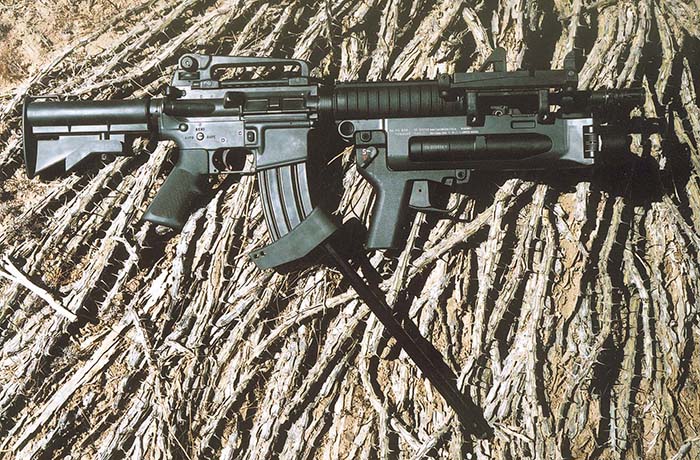
Mounting made easy
The current series-production HK AG-C Add-on Grenade Launcher is a detachable module that can be attached to the host weapon using any available MIL-STD-1913 rail, such as that found on the Rail Adapter System for the M4 and M16-series weapons. The AG-C is a self-contained launcher with its own safety and firing mechanism housed within an integral vertical pistol grip. The user can detach the HK AG-C from the rifle/carbine without special tools and fire the launcher, with decreased hit probability, in the event of an emergency, separate from the weapon as a grenade-pistol. To remove the launcher from the carbine simply retrieve the L-shaped 5 mm Allen wrench stored in the slot provided in the receiver just above the ambidextrous safety/selector lever. Loosen the locking screw completely (it is captured so it cannot be lost in the field). This screw is located where it attaches to the bayonet stud. The launcher is simply slid forward off of the mounting rail and removed from the host weapon. Reverse this order to return the launcher to the same or to a different weapon. Because the sights are attached to the launcher itself and not to the rifle, the zero of the grenade launcher is retained, thus avoiding the time and hassle of rezeroing.
Features, Operation
As mentioned previously, the HK AG-C features a side-opening (swinging) aluminum barrel that opens under spring pressure to the left with the depression of an ambidextrous breech release latch located within the trigger guard of the launcher. This feature allows the weapon to be loaded and unloaded easily from awkward shooting positions. It also provides the user with the means to fire 40x46mm rounds that are 134mm (5.28 inches) or longer in overall length, an option not possible with slide-action style launchers such as the U.S. M203. The side-swinging barrel presents the spent case directly into the waiting hand of the grenadier. No automatic ejector is provided in the HK AG-C. The spent case or unfired live round is removed manually. Finger recesses are provided at the rear of the chamber to ease extraction even with gloved hands. Auto-ejectors in a grenade launcher may seem advantageous, but their additional complexity, especially in adverse environments or when firing poor quality ammunition, may severely affect the reliable operation of the launcher. With the HK AG-C launcher the “KISS” principle was applied and has proven effective and popular with the users. The AG-C is so simple there is NO operator disassembly procedure for the launcher.
One might ask what about the left-handed gunner? How about a barrel that could swing left or right? Once again this complexity in design was avoided to insure reliability in action. The design is effective nonetheless. The lefty uses his right hand placed on the pistol grip of the launcher to operate the controls of the launcher. This places his hand at the correct location to load and unload the breech by simply rotating the weapon system 90 degrees to the right. This procedure is nearly as fast as that accomplished by the right-handed operator.
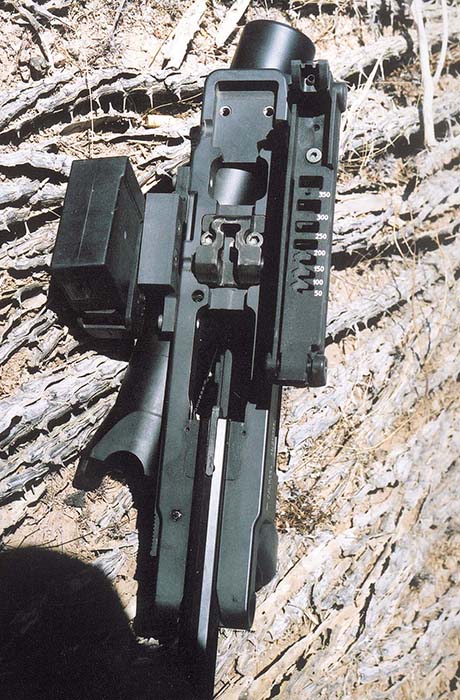
All operating controls and the sight-mounting locations are fully ambidextrous for right- and left-hand use. All controls can be operated with only the fingers of the firing hand from any firing position. The careful selection for the location of each operating control insures that the actuation and status of each control is fast, easy, intuitive and can be accomplished by the user by feel only, if necessary, as is often the case under low-light conditions or while under stress. The side-loading breech places the spent case or live round at the right-handed operator’s left hand to facilitate speed reloading during multiple target engagements or while operating under the cover of darkness. The British Special Air Service (SAS) proved these attributes superior during the testing of the HK AG-C and eventual adoption of the launcher in 2000 where the HK AG-C was selected over other existing add-on grenade launchers.
User Safety Assured
The barrel release latch and mechanical safety/selector lever are located in a position within easy reach of the fingers of the shooters strong hand. This positioning, however, also eliminates the possibilities of inadvertent activation during handling. The rotating manual safety/selector lever is positioned behind the breech in a location designed to both offer easy actuation by the user and still prevent accidental movement even if the safety/selector lever is accidentally swiped off. The double-action-only (DAO) trigger function prevents inadvertent firing if the trigger is pressed partially. A total of 11-16 pounds of pressure on the trigger are required to fire the AG-C.
The DAO trigger mechanism employed in the HK AG-C is not controlled by the opening or closing of the breech as in the M203 design. The use the trigger-cocking DAO firing system allows the user to fire the launcher through the simple squeeze of the trigger. As the HK AG-C employs this DAO trigger mechanism, the internal striker is never cocked until the very moment of firing. Thus the launcher can be repeatedly loaded and cleared without being cocked, a feature that reduces the chances for accidental or impact induced discharge. This feature also allows for multiple-strike capability in the event of a stubborn (hard) primer and the robust hammer and drive spring ensure strong primer indent even after prolonged use or in cold climatic conditions where primer sensitivity can be less than optimum. No other controls, to include the breech release latch or barrel, need to be actuated to allow for repeated attempts by the operator to fire the chambered round.
A breech safety device also insures that the chambered round cannot fire unless the breech is completely locked closed. Accidental firing caused by rough handling or drops up to 2 meters in height are avoided by the design of the trigger mechanism.
ights
As mentioned earlier, the sights of the HK AG-C are attached directly to the receiver on rigid mounts that can be removed by the operator with a simple Allen wrench. This allows the sights to be placed on either side of the launcher for right or left hand use. The dual sight-mounting points on the AG-C also provide a means to attach dual sighting systems, a reflex sight and back-up mechanical sight for instance.
Standard mechanical sights for the AG-C are comprised of a lightweight polymer folding front Patridge-style post with protective ears and a folding rear ladder sight. The rear sight is graduated from 50 to 350 meters in 50-meter increments. Adjustments for windage and elevation are possible through the use again of a simple Allen wrench.
Mechanical leaf and ladder sights in this writer’s opinion have also been the second greatest detractor from the accuracy potential of add-on launchers. The first is the 40x46mm ammunition with poor round-to-round dispersion, typical of the M781 training and practice (TP) rounds most US troops train with. Fortunately, the combat rounds are superior in their accuracy and there are excellent and very accurate TP rounds available from foreign manufacturers, in particular the NICO TP Tracer round. This training round provides excellent round-to-round dispersion – less than the 5-meter bursting radius of the cartridge. The tracer element provides a telltale visible red trace to the target, and unlike the more common orange “marker” rounds, is useful for training under low-light conditions.
To take advantage of these more accurate rounds and to eliminate the operator-induced aiming errors with mechanical sights, Heckler & Koch has developed, in conjunction with the Ring Sight Company in the U.K., a very simple yet effective reflex sight for use with the HK 40mm family of AG launchers. The Ring Sight uses a solid glass block with etched reticle pattern. This reticle provides a series of simple aiming dots, thus eliminating the need to align the coarse front and rear sights and target, a difficult task especially on targets beyond 150 meters. Simply place the fine transparent aiming dot on the target and mash the trigger. Grenadiering made easy. Increases in hit probability are easily doubled with most shooters, as is the ability to deliver multiple rounds to the same aiming point. The Ring Sight reticle pattern provides range-to-target numbers corresponding to the appropriate aiming dot out to the maximum effective range of the round.
The reflex sight is also powered for low-light use using a replaceable tritium source and can be used with NOD’s. The sight is externally adjustable for elevation and windage using an Allen wrench. The sight is mounted to the AG-C launcher on a removable mount that attaches to the receiver. On other host weapons to the HK AG launchers, the reflex sight can be attached to the rearward portion of the receiver, as is the case when used on the HK G36 Rifle or Carbine or US M16A2 wherein the sight is attached to the carrying handle near the rear sight.
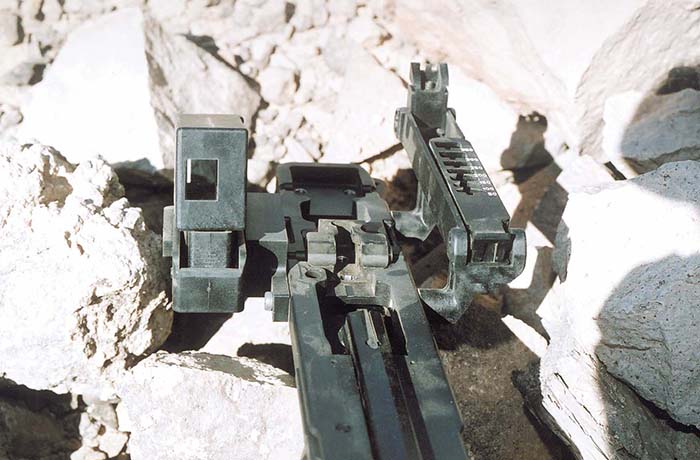
Ammunition and the HK AG Launchers
The HK AG-C is fully compatible with all 40x46mm low-velocity (LV) rounds produced and in service around the world, to include all NATO and US rounds. The HK AG-C can chamber and safely fire any length 40x46mm LV round due to its single-shot side-loading breech design. This would include compatibility with programmable air-bursting rounds that are being currently developed in this caliber for launch from add-on 40mm shoulder-fired grenade launchers similar in nature to the HK AG-C. With the right ammunition the AG-C is highly accurate, more than capable enough to deliver multiple rounds within the standard 5-meter bursting radius, which is standard for the HE-Fragmentation rounds most often used in combat.
Proven System
The Heckler & Koch Anbaugerat Grenade Launchers are state-of-the-art, have been developed for ease of operator use and with guaranteed operator safety. They have been exhaustively tested in all climatic conditions to include multiple user and HK tests in the deserts of Yuma, Arizona and Kuwait, the jungles of Brunei and the cold weather climates of Norway, Canada and Alaska. They have proven rugged and effective in combat operations in Kosovo, Bosnia, Afghanistan, Iraq and certainly many other unmentionable locations around the globe.
Future Enhancements
The newest variant of the AG-C grenade launcher is termed the AG-C/EGLM (Enhanced Grenade Launcher Module) and adds a quick-detachable retractable butt stock to the system. This butt stock slides into the female attachment groove that marries to the MIL-STD-1913 rail. The AG-C/EGLM incorporates a spring-actuated stock release lever on the left rear portion of the receiver. Four length-of-pull positions are available to allow the operator to adjust for various body sizes and to account for load bearing equipment, heavy clothing and especially, body armor. With the buttstock attached, the AG-C becomes a stand-alone 40mm launcher for times when the assault rifle is not required. Sling attachment points are provided for use with standard carrying slings.
The greatest promise for increased combat capability in 40x46mm grenade launchers lies in improved ordnance (more accurate, more lethal, increased lethal radius, air-bursting) as well as fire control systems that can provide not only day and night time capability but also allow the user to accurately engage targets with a single round without having to “walk” the rounds onto the target. First round hit probability out to the maximum effective range of the round must be improved to enhance the usefulness of the system while at the same time reducing the combat load of the warrior. It should be possible with existing technology to make certain that every one of the 36 rounds typically carried by the grenadier falls within a lethal radius of the intended target.
Accurate ammunition and launchers like the HK AG-C exist. The challenge to industry now is to marry these components with a sighting system that provides the precise range-to-target and corresponding ballistic adjustment to at least 5 meters to guarantee first round casualties on the target with the first round fired. If not, the first few rounds are little more than wasted position disclosures for the grenadier.
| This article first appeared in Small Arms Review V7N3 (December 2003) |



